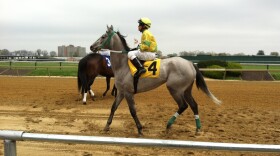For Kentucky Derby week, the Innovation Trail is partnering with WEKU and Louisville Public Media to explore how technology is changing the horse racing industry. This is part five of a five-part series.
It’s often the trainer, the horse owner, then the jockey who are celebrated after a Triple Crown race.
But behind the glitz and glamor, preparing the horse is often a demanding 365-day-a-year process.
“People who is out of the track, don’t know how we do what is behind the race,” says Arturo Espinosa. Espinosa is visiting Churchill Downs’ Backside Learning Center, which offers education and life skills services to “backside” workers - including grooms, hot-walkers and exercise riders.
Industry professionals estimate at least 70 percent of “the backside” is made up of foreign migrant workers.
But a potential change to federal visa laws could make the process of hiring workers outside the country more arduous and more expensive for trainers.
The changes would give American workers first crack at employment, but these are jobs many Americans won’t take.
“They’re basically forcing the U.S. employer to hire Americans,” says Julio Rubio, a liaison for the National Horsemen’s Benevolence & Protective Association (HBPA), a trade organization for owners and trainers.
“We go above and beyond to try to hire Americans,” says Rubio.
But, if approved, the U.S. Department of Labor’s new regulations will ask for more.
The new visa laws increase the minimum number of weekly working hours from 30 to 35, but shorten the maximum number of months that define temporary employment from ten to nine. Furthermore, trainers will have to spend more time trying to prove why foreign employees are needed.
A federal judge in the Northern District of Florida issued a nationwide preliminary injunction last month barring the Labor Department from implementing the changes.
Backside realities
But while controls outside track gates could be tightening, inside it’s a little looser.
“It’s like a microcosm of society,” says Jennifer Hoert, director of the Backside Learning Center.
“If you see violence in society, we see violence on the backside,” Hoert says. “If you see people that have gambling, drug, alcohol additions out in society, they’re back here too.”
Many people call the backside its own community.
As such, it requires what all communities need: social services, recreational activities and healthcare. But many say the horse racing industry is too fragmented to offer a consistent level of service.
Nonprofits in each state usually pick up the tabs for these services because the racing industry is not nationally regulated.
Organizations in states like Kentucky and New York often support a greater variety of programs because keeping the backside healthy supports the industry.
Kentucky, New York and California all donate un-cashed betting tickets to associations or organizations that support various programs for horsemen.
The Kentucky Racing Health & Welfare Fund received over $2 million this year alone.
“Lonesome” work
But no state can fully protect backside workers from the side effects of the job.
“You be lonely on the backside and you’re by yourself,” says exercise rider Franklin Castillo, originally from Panama.
Castillo acknowledges what many say is a result of being transient. Many workers follow the racing circuit throughout the year.
“You no got your wife, or your girlfriend - you got nobody,” Castillo says. “You is lonesome.”
Most foreign-born workers send money back home, he says, so every provided service helps.
The Labor Department is trying to draw more American workers to the backside, giving them a shot at a homegrown American dream.
But for Arturo Espinosa, his dream resides in another country.
Espinosa, who isn’t married, says he wants to return to Mexico City one day to be with his parents.
But first he wants to win one big race. So each morning he wakes before daybreak to prepare, wash, scrub and take care of the horses.







